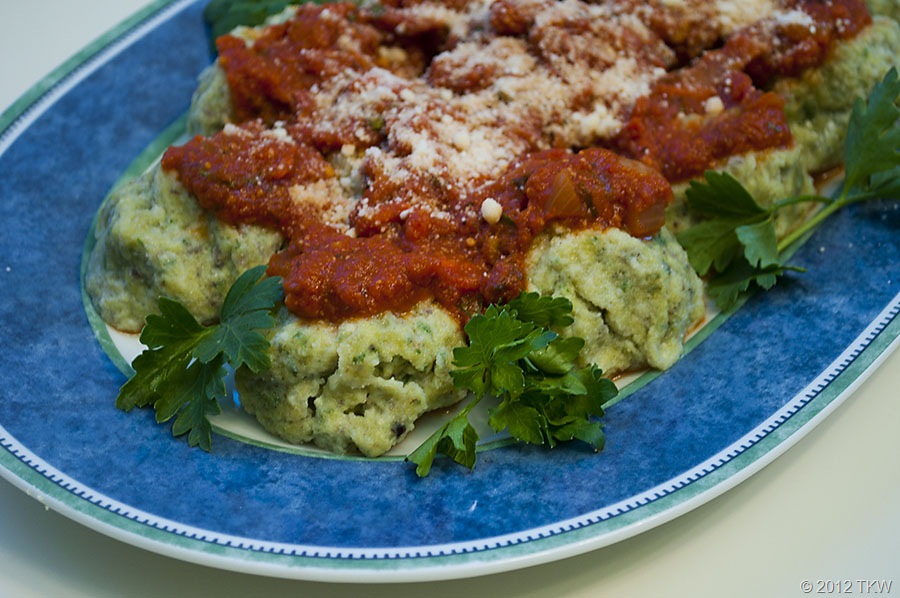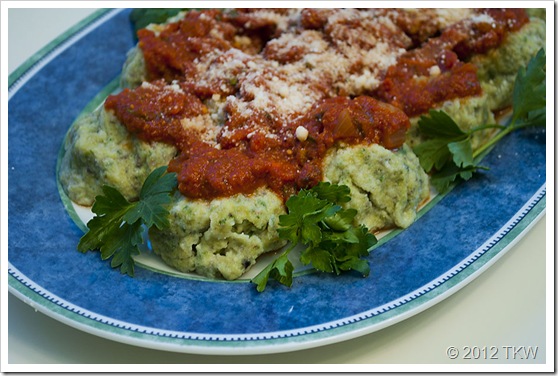When I was flitting around the blogosphere, my eyes landed on Sippity Sups Gnudis with peas, bacon and mint, these guys have been on my must make list for sometime, after all the main ingredient is Ricotta, and I’m a little freakish about cheese. As I was reading Greg’s post, I thought to myself, I have the peas and the mint I just need to go out and get some ricotta.
And I did, several days later. I bought myself the best organic whole milk ricotta we have in the area. The baby boy was going to be gone so McGyver and I were planning on getting gnudi…brown chicken cow cow (BTW that’s my version of porn music).
Wait, you haven’t heard of gnudis before? Gnudi (pronounced noo-die) are sometimes called the ricotta gnocchi, and some say they got their name because gnudi, in Italian is just like it sounds, it means naked.; in this case it refers to the inside of the ravioli but no pasta…a naked ravioli. I explained this to McGyver and he said so a meat ravioli without the pasta is a meatball/gnudi, would that make a cheese gnudi a cheeseball? No McGyver it doesn’t, I’m the only cheeseball here!
Maybe I should get back to my gnudi. I’m all set to make them and I brought up Greg’s recipe and went, ugh they are supposed to sit overnight, however after a little snooping around not every recipe called for it. Right, now back on track, I grabbed my mint and peas and ugh again. My fresh English peas were swimming in an unappetizing pea sludge.
Well dammit I had my heart set on making gnudi, you know when you really want something you get resourceful. I had a large bunch of basil that was probably one day away from being an unfortunate loss like my peas, hmmm pesto gnudi..kind of. I didn’t have any pine nuts and I didn’t have enough basil and I didn’t make a pesto like with olive oil and everything but I did puree the basil, garlic and parsley and there was parmesan already in the recipe that I was basing mine off of…it’s all kind of pesto inspired.
I ended up using Giada’s recipe from Food Network because it was simple. I took some notes from other recipes and coated my gnudi in semolina so it had a more pasta-ish exterior and I let it set in the refrigerator for several hours somehow sensing that it would make my gnudi have the stick-to-it-ness that it would need. When all was said and done, it was almost 9:00 that night before we ate. I snapped a quick shot under the worst conditions and almost didn’t post this because of, the “ugh” factor with my journey and the less than stellar photo.
However, after one bite I decided not to keep this from the world! A heavenly cheesy, garlicky cheeseball gnudi that is 10 times easier to make than gnocchi and much more fun to say, snicker, giggle, giggle…
So without further a do, crappy photo or not, here’s my gnudi inspired by Greg and loosely adapted from Giada.


- 1 cup whole milk ricotta cheese
- 1 cup basil leaves
- 1 cup parsley, leaves only
- 4 cloves garlic
- 1/3 cup pitted Kalamata Olives
- 1 cup grated Parmesan
- 2 eggs
- 2 egg yolks
- 1 teaspoon salt
- 1 teaspoon freshly ground black pepper
- 1/4 cup all-purpose flour
- 1 cup semolina for coating
- 1 jar store bought marinara sauce, heated
- In a food processor or blender, blend the basil, garlic, parsley and kalamata olives. In a large bowl, mix ricotta, basil mixture, Parmesan cheese, eggs, and yolks. Stir in salt, pepper, and flour. Form mixture in to small golf sized balls.
- Dredge the formed gnudi in the semolina to coat, tapping off the excess. Lay out on a lined baking sheet, refrigerate 2 hours or overnight. Bring a large pot of salted water to a boil. Slide formed gnudi into the boiling water. Be careful not to overcrowd the pan; work in batches if necessary. Remove the gnudi using a slotted spoon after they float to the top and have cooked for about 4 minutes.
- Arrange gnudi on a platter and lightly drizzle with marinara sauce.

Informal Cookery Definitions A to Z
Calorie. A unit of measurement, that’s used to measure fuel value for food. This is valuable knowledge to base calorie intake versus what the body needs for fuel. When the calorie intake does not match the individuals fuel needs for long periods of time there could be an unhealthy weight gain or loss.
Camembert. (KAM-em-bair). Is a soft creamy cow’s milk cheese with a thin rind from France, it is named after the village of where it was produced. It is similar to brie, however it is made in a different region and it is made in small cheese rounds versus large ones like brie. The smaller rounds means more surface area has the rind and therefore a distinctly different taste.
Can. The can, an item made of sealed metal to extend the shelf life of food, was invented but not produced by, a Frenchman named Nicolas Appert. Cans were made of tin, but now are made of aluminum. The beverage can is a progression of the common can.
Canapé. (kah-nah-PAY). Is a French word but has nothing to do with the afore mentioned can. The word means sofa or couch and is probably used to describe the food sitting atop bread. The canapé is a bite sized piece of bread or toast topped with small bits of food.




Somehow, I’ve never heard of gnudi. Now that I have though, I freakin need it in my life! Pesto…sort of pesto…or whatever this gnudi may be, it sounds delightful.
Colleen, I can’t believe you of all people haven’t heard of gnudi. When you aren’t cooking up sweets you are making something cheesy…meatless of course. This is perfect for you!
OMG … I loved your story and your gnudi 🙂
This is my first time to hear about gnudi. I find it interesting. I am curious of its taste. Looks delicious to me. I just have to try and make this. Thanks for sharing. =)
Raquel, it’s like eating pillows of ricotta, worth the try!
OK–loved all the punniness! I have never heard of gnudi either but as a fellow lover of all things cheesey, I am ready to try it. (I kinda just like to say it too!) 🙂